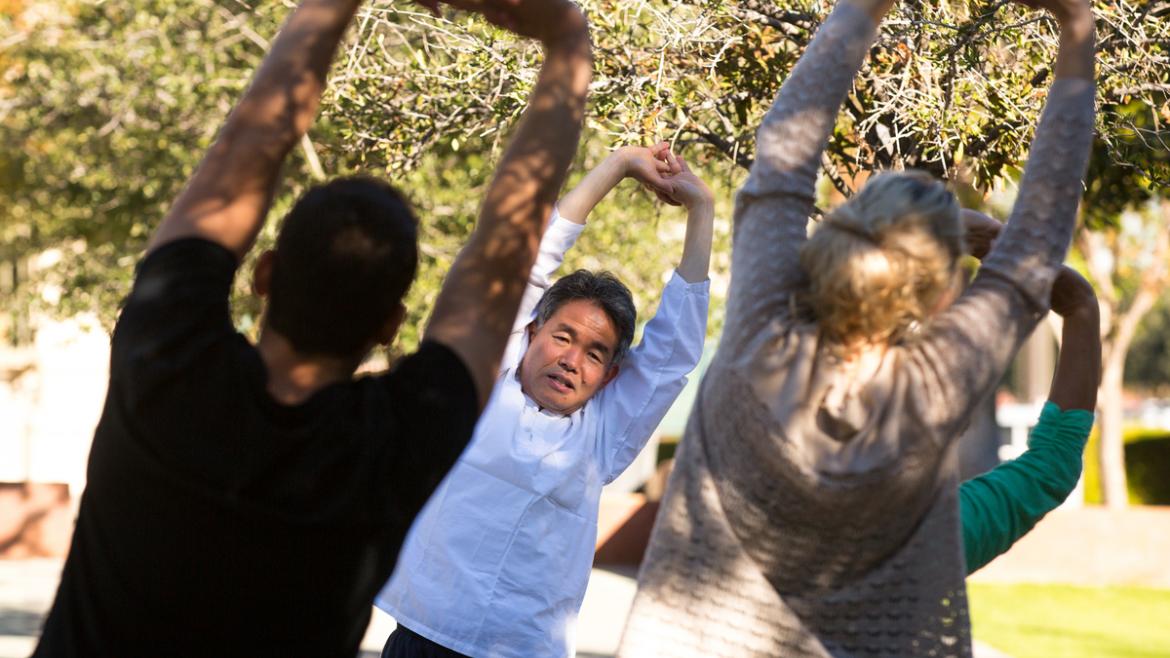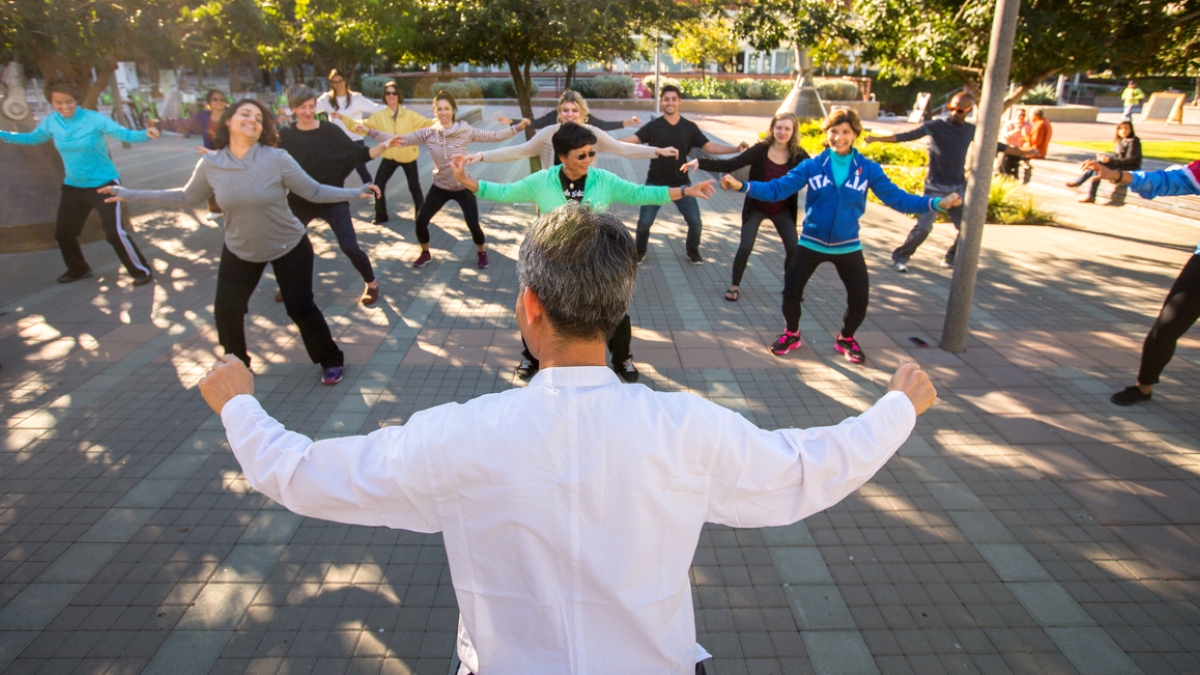When the students are ready, the teachers will appear.
And they did.
The instructors came in the forms of a gray-haired Baby Boomer from California and a lean, gentle Korean from Down Under. They were standing in Phoenix’s Civic Space Park to teach a group of 15 people the healing properties of Tai Chi and QigongQigong is an ancient Chinese health-care system that integrates physical postures, breathing techniques and focused intention..
Dr. Roger Jahnke asked the pack of ASU staff members and graduate students to loosen up with a repertoire of breathing techniques and slow, fluid body movements.
“See if you can feel some sort of energy between your hands,” said Jahnke, who is the director of the Institute of Integral Qigong and Tai Chi in Santa Barbara, California. “When you open your hands, see if you can open your body. Open the body and the space around the heart.”
Jahnke and Dr. Byeonsang Oh, each a renowned Tai Chi and Qigong expert, shared their wisdom outside ASU’s Downtown Phoenix campus in November as part of a study piloted by Linda Larkey, a professor with ASU’s College of Nursing and Health Innovation, testing the efficacy of Qigong/Tai Chi for improving fatigue and other symptoms — sleep quality, anxiety, depression and cognitive function — in women who have been treated for breast cancer. These and other associated symptoms can persist for months, even years, after treatment ends.
The study, which is funded by a National Cancer Institute grant, binds Larkey and a group of other investigators from ASU, the University of Arizona, Mayo Clinic Cancer Center and Maricopa Integrated Health Systems, who believe that meditative movement such as Qigong and Tai Chi can help recovery and rejuvenation in women between the ages of 45 and 75 who are recovering from breast cancer.
Jahnke and Oh share the same belief.
“Chinese medicine believes there are energy channels in our body so when we open those up, we improve our circulation and we become healthy,” said Oh, who is a clinical associate professor at Sydney Medical School in Australia and a Harvard Research Fellow. “Qigong and Tai Chi can improve all of the symptoms from the cancer period and improve their overall quality of life.”

Dr. Byeongsang Oh leads a group in Tai Chi movements at City Space Park in downtown Phoenix.
Photos by Charlie Leight/ASU Now
This isn’t just theory; he said he has seen it work.
“We initially start with them in the hospital and after 10 weeks, the oncologist is asking me, ‘What is going on with my patients? It’s a miracle.’ I told him, ‘It’s not a miracle. We are teaching them to heal themselves,’ ” he said.
Jahnke said the healing powers of Qigong and Tai Chi is something he has known for decades, but there is an important subtext to the conversation: preventable treatment and economics.
“The statistic for this nation in terms of costs to preventable disease is, well, embarrassing,” Jahnke said. “We spend medical money on people who could be keeping themselves well at home for no additional cost. It’s odd that the most sophisticated society in the world would overlook this simple but exquisite economic idea that self-directed human beings can do all kinds of amazing things.”
ASU microbiology student Hussein Hadid, who participated in the training session, said “mindful practices” such as Qigong and Tai Chi should be incorporated in all future oncology rehabilitation programs.
“Stress does so much more to our bodies than people can ever know,” Hadid said. “It impedes judgment, it impedes our immune system and can lead to heart disease and even cancer. Tai Chi relieves that stress hormone and allows you to be in the moment.”
Being in the moment is important to Maja Pedersen, a first-year doctoral student in the College of Health and NutritionThe College of Health and Nutrition is in ASU's College of Health Solutions..
“Everybody needs a reminder to check out of the daily stresses of life and take some time away from that to connect with our bodies and become aware of what’s inside of us,” Pedersen said. “I find the type of movement in Tai Chi to be very helpful. When we think of physical activity, we have a tendency to think of straight front-to-back movement. From my experience, that doesn’t leave open [space] for a creative flow of energies in our bodies. So I’m looking forward to sharing this practice with individuals who are in great need of healing.”
Though he believes in its methods, Jahnke knows the healing abilities of Qigong and Tai Chi could take a while to implement.
"This is a no-brainer and something we've known all along, but to normalize this into an entire society — many mountains to climb."
Recruitment for the study will begin shortly, with ASU working with local community organizations and oncologists. For more information, please contact the Recovery & Rejuvenation study staff at 602-496-2329.
More Health and medicine

The surprising role of gut infection in Alzheimer’s disease
Arizona State University and Banner Alzheimer’s Institute researchers, along with their collaborators, have discovered a surprising link between a chronic gut infection caused by a common virus and…

ASU, University of Wisconsin partner to empower Black people to quit smoking
Arizona State University faculty at the College of Health Solutions are teaming up with the University of Wisconsin to determine which treatments work best to empower Black people to quit…

New book highlights physician wellness, burnout solutions
Health care professionals dedicate their lives to helping others, but the personal toll of their work often remains hidden.A new book, "Physician Wellness and Resilience: Narrative Prompts to Address…
